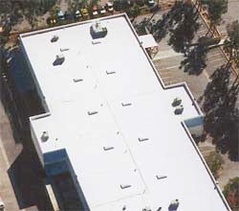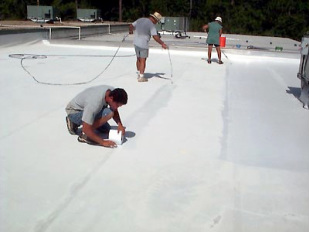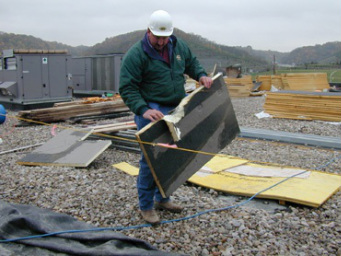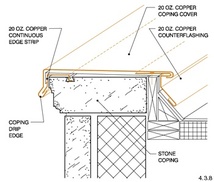 Cool Roofs Although the primary concern with roofs is water-tightness, you can also gain benefits for energy efficiency. Roofs make up a large proportion of the heat retaining surfaces in populated areas. In some highly concentrated areas, as much as 27 percent of the land cover is roof surface. This can cause what is referred to as an "urban heat island" - a region where the temperatures can be several degrees warmer than the surrounding area. Buildings with dark roof surfaces get hotter and stay hotter longer. Air conditioners must work harder and longer to maintain comfort for occupants. A reflective or white roofing system can keep a building cooler and save money on air conditioning costs. The ENERGYSTAR® Roof Products Program provides guidance in selecting roofing products, as well as a list of products that meet the qualifications established for cool roofing products. This list of qualifying products identifies low-slope roof products that have an initial reflectance of at least 65 percent and a reflectance of at least 50 percent after three years of weathering. You can explore the ENERGYSTAR® site through this link.  Do You Really Need A New Roof? Years ago I saw a 25 year old tar and gravel roof that you could almost see through it was so worn, but it was only leaking at the edges where the metal gravel stop was embedded in the felts. The movement of the metal had created cracks. Currently I know of a 28 year old roof that is virtually problem-free because it gets yearly maintenance. Replacement will cost $100,000 eventually, but less than $1,000 a year in maintenance has kept that expenditure at bay for over a decade. What should you check before you spend $$$ for re- roofing? • Get more than one opinion. Second and third opinions are necessary. Get advice from the most knowledgeable expert you can find. When all else fails, use a leak detection service (infrared sensing). • Maintain your roof every Fall. Water rarely enters the building through the open surface of the roof - almost always at the penetrations and edges. Yearly maintenance can get you significant extra life. Fall is the best time for maintenance. • Be wary of rooftop equipment. Finally, rooftop equipment is the bane of roofs. A bit of detective work can tell you if any equipment on the roof is near the area of the leak. Many times contractors make "modifications" to your roof with limited knowledge of roofing. Occasionally, their equipment is the source of the leak! If a replacement is truly called for, consider the best roof system that you can afford. The simple fact is that a cheap system will probably be replaced three times before a top quality roof is replaced. The total cost and inconvenience of an inexpensive roof will lose out in a life cycle cost analysis.
 How To Avoid Re-Roofing Our study of "Top Building-related Issues" lists leaking roofs among the top three issues, and often it is number one. You get the impression that you can't beat Mother Nature. Actually, effective roofing projects are completed all the time, but you definitely have to work with nature to achieve success. The average life for a commercial roof is seven years. This is less than half the common expectation of 20 years. The frightening fact: if the average is seven years, half the people are getting even less. One scenario that I suspect is a major contributor to the low life-expectancy of commercial roofs is replacing your whole roof because of a leak that your roofer can't find. The situation is like Rubik's Cube - there are a lot of strategies that don't work. My experience is that there are also many strategies that do work. You should know about these successful strategies. How To Get A Good Roofing Job To help ensure a high quality, trouble-free roof or re-roof project, which may not end up costing you any more, add the following requirements to your bidding documents and insist on their implementation: • Unconditional 2-year workmanship and water-tightness warranty. (Kentucky Department of Education requirement) • Manufacturer's standard warranty of 10, 15 or 20 years - the longer the better. • A Contractor's Qualification Statement with slightly higher than typical requirements for years in business and number of similar roof projects, say, 10 years and 20 projects. • Clear and specific details of every joint, termination, change in materials, and flashing condition. • Pre-installation meeting with attendance required for manufacturers' representatives from both the insulation and roof membrane companies. • A schedule with a representative from the roof and insulation manufacturer present on each day when their product is being installed and flashed. The norm is one visit at the end of the job when things are hidden from view. That is not adequate.  Roof Flashing The roof is one of the most essential parts of a building as it protects occupants, contents and interior of the structure from the elements. The most pervasive and difficult weather element to control is water. Roof flashing is usually the last line of defense in the battle against water penetration. Flashing forms the intersections and terminations of roofing systems and surfaces to thwart water penetration. Locations include: wall flashing, expansion joints, counter flashing, base flashing, built in valleys, scuppers, gutters, downspouts, exposed trim and fascias. Flashing materials must be durable, low in maintenance, weather resistant, able to accommodate movement and compatible with adjacent materials. Experienced and skilled installers are necessary to plan, cut, shape, fabricate and install complicated shapes into permanent 3-dimensional, continuous forms. Copper flashing offers beauty in its familiar protective green patina and a long-service life; it will not need to be replaced when the roof is replaced. On a life cycle cost basis, copper flashing is the best choice. A close second is stainless steel. Copper isn't appropriate for every project. Comments are closed.
|
x
Archives
February 2024
Categories
All
|
Architekwiki | Architect's Resource | Greater Cincinnati
© 2012-2022 Architekwiki
© 2012-2022 Architekwiki






